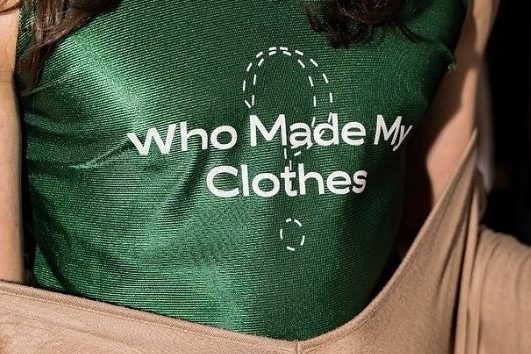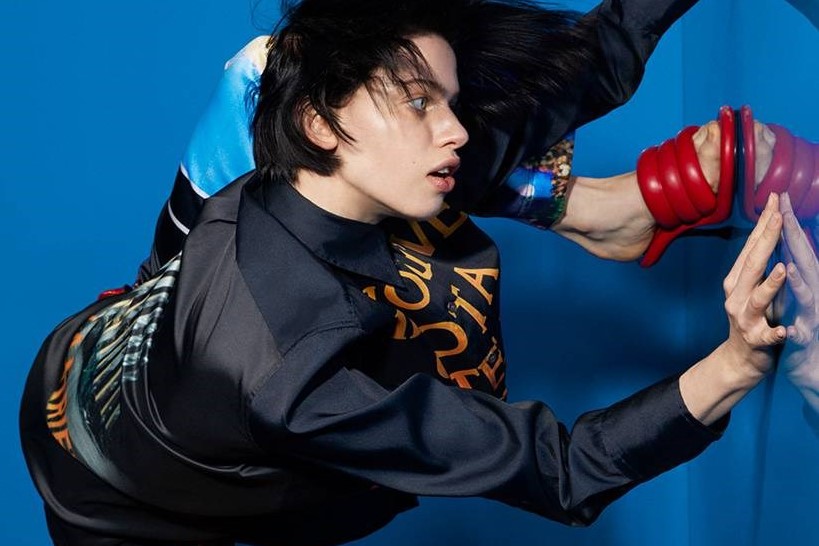
Inside the global fashion summit attempting to un-fuck the planet
The Copenhagen event saw the likes of Shein, H&M, and the Danish royal family butt heads with activists and local manufacturers
The Global Fashion Summit: Copenhagen Edition, previously known as the Copenhagen Fashion Summit, is an international forum for sustainable fashion. First launched in 2019, the 2022 meeting marked the first in-person event since the pandemic. Panels, keynote speeches, and a deeply awkward meditation session were all part of the programme which followed the theme “Alliances for a new era”.
Not quite as exciting or shareable as fashion week, this industry event hasn’t really found its way into the general fashion discourse yet, but once you mined down past endless mentions of ‘stakeholders’, ‘value chains’, and ‘sectoral approaches’, there were some interesting talking points and bold voices to be found – and there are plenty of aspects to be improved too. Here’s what you need to know.




THE BIG ANNOUNCEMENTS
Given the amount of press in attendance, the GFS is the perfect time for brands to announce big new plans. On day one, Ralph Lauren announced the launch of ‘Live On’, a new circularity strategy that will “enable all past and future products to live on responsibly by 2030”, according to Vogue Business. A multi-layered plan, the brand will apply different solutions to different products. For instance, for long-lasting pieces like handbags, repair will be key, while for less durable products like t-shirts, recycling will likely play a bigger role. Cradle to cradle certification for certain items and ramping up resale are all part of the plan too.
Circularity also played a part in Copenhagen-based GANNI’s introduction of three “Fabrics of the Future”. A collaboration with zero-waste woven textile company Stem, also based in the Danish capital, came in the form of a three-piece, circular denim-esque collection comprising a dress, jacket, and trousers; Mylo, a mycelium-based leather alternative, was used for limited edition wallets and one-of-a-kind bags; and Circulose (well, 15 per cent of it mixed with viscose) was the material of choice for two new pairs of trousers which will be launched for pre-fall. “80-85 per cent of our carbon footprint is derived from the product, so obviously it’s a huge priority for us,” said GANNI founder Nicolaj Reffstrup.
Other announcements included the news that H&M Group and Lululemon were amongst the funders for a new $250million Fashion Climate Fund to “decarbonise and modernise” supply chains, and Mulberry revealed the introduction of Digital IDs to its leather products (rolling out to all products by 2025) to make tracing product origins, reselling, and authentication much, much easier.
The announcement that got the biggest reaction by far, however, was when Liz Ricketts, from the Or Foundation, a non-profit based working out of Kantamanto, revealed that SHEIN would be providing $15 million over three years as part of its new EPR (Extended Producer Responsibility) Fund. There were both gasps and cheers from the audience and, later, a very mixed reaction on social media with some supporting it and others heavily criticising the move. The funding is absolutely necessary – 15 million garments a week arrive in Ghana, a country of 32 million people and according to Ricketts, 40 per cent of what arrives ends up as waste – but Shein, whose production outstrips that of the likes of boohoo, Zara, and H&M to an almost unbelievable degree, was likely the last brand people would expect to support the Or Foundation’s work.
The money will be used on a number of different initiatives including expanding an apprenticeship programme for the young women who carry heavy bales, piloting recycling initiatives, and incubating businesses which turn the textile waste into new products. Some of the money will also be redistributed to “allied organisations in Ghana”.
After making the announcement, Ricketts threw down the gauntlet to the brands in the room, calling on them to admit that their clothes end up in Kantamanto, and take financial responsibility for the environmental and social harm they cause. “We have been calling on brands to pay the bill that is due to the communities who have been managing their waste, and this is a significant step toward accountability. What we see as truly revolutionary is SHEIN’s acknowledgement that their clothing may be ending up here in Kantamanto, a simple fact that no other major fashion brand has been willing to state as yet,” Ricketts said.
STAND OUT VOICES
While the phrase “Eight years to go…” loomed over the shoulders of all speakers as part of the set, alluding to the climate targets which need to be met by 2030, the atmosphere wasn’t as revolutionary or urgent as you might hope. But there were a few voices which stood out.
Liv Simplicano of Fashion Revolution was the first to mention the need for degrowth, a stark contrast against Adam Karlsson, CFO of H&M Group, noting, “we are and we always will be a growth company”. A removal from the many corporate voices which dominated the conference, Simplicano served up a reminder: “There’s no fashion on a dead planet.”
Bobby Kolade is the designer behind BUZIGAHILL, a brand which redesigns secondhand clothes and “redistributes them in the global north, where they originated from”. He also refused to sugarcoat the exportation of waste. “Africa is no longer a charity box,” he said. “You have your own system, throw it away and deal with it!”
WHO WAS THERE, AND WHO WASN’T
The list of brands and companies present at the summit was almost endless. The likes of GANNI, ASOS, H&M, Kering, Allbirds, Burberry, Nike, and Ralph Lauren, were there alongside organisations including Fair Wear Foundation, Fashion Revolution, the UN and Fashion For Good. The Crown Princess of Denmark was also in attendance, speaking on the first morning. Having an entire room stand for royalty was certainly jarring given that the spectre of colonialism hung heavy over the venue.
Panels such as “Subverting Fashion’s Historical Exclusion” and “Histories And Futures For Fashion Education” featuring speakers including Frederica Bosworth, Ngozi Okaro, and Moussa Mchangama brought themes of decolonisation, representation, and inclusion into the summit, and it was better for it, but the balance of voices was off and many were notably absent. “This forum is very Eurocentric, the majority of the brands here are from Europe… but all voices need to be heard,” said Shams Mahmud, who owns a denim manufacturing company in Bangladesh.
“I want to acknowledge that diversity of our speakers should be better,” Federica Marchionni, CEO of the Global Fashion Alliance, said, alluding to difficulties with travel. But it wasn’t the most compelling argument given that logistics were in place for the delivery of remote and pre-recorded addresses. Another summit is due to take place in SE Asia which, hopefully, may offer broader representation.
WHAT’S NEXT
The summit wasn’t a perfect representation of perfect progress (which realistically doesn’t even exist) but that doesn’t mean there weren’t a few interesting ideas and initiatives on the table. Some things are happening that are moving fashion in the right direction, like sacrificing growth in the name of sustainability. “We’ve decided to phase out our virgin leather by 2023,” said Reffstrup. “It’s a huge part of our total sales but virgin leather is also a huge part of our carbon footprint, so there’s no way around it. We’ve got to do it.”
Fellow Copenhagen brand Cecilie Bahnsen is taking a similar approach in stripping back to two collections a year. “For me, it was the best decision we made,” said the brand’s eponymous designer. “Of course we knew it would mean that maybe financial growth would slow but this is what we need to keep the level of design and passion, focusing on creating the most beautiful product you fall in love with.”
Alongside focusing on the careful craft her brand is known for, Bahnsen is also getting stuck into data to make sure she’s making the right changes in the right places, and it’s a move being seen across the board. Vestiaire Collective, for instance, recently released its first impact report. Why, when the brand is considered a solution rather than a problem? “We can’t manage what we can’t measure,” said co-founder Sophie Hersan. Measuring impact is the only way brands will know whether their grand plans are actually doing any good, and for chief sustainability officer Dounia Wone, she wanted to know, among other things, if Vestiaire was offsetting new purchases, and if secondhand purchases had less impact than new. The answer to both was yes. So now the plan, she explained, is encouraging more local sales to reduce the impact of transit, and adding sustainability prompts to the platform so customers can make the best choices.
Vestiaire’s investor Kering is also big on data, having created the pioneering Environmental Profit and Loss (EP&L) tool which helps quantify environmental impact (something the secondhand platform has fully embraced). Now Kering is turning that exacting approach towards biodiversity. Having announced a biodiversity strategy a few years ago, it’s now settled on seven projects in six countries where it will help protect and regenerate nature. “We looked at the environmental impacts through the EP&L, we identified the four big raw materials: cotton, leather, silk, and cashmere,” said Kering’s chief sustainability officer, Marie-Claire Daveu. “We are very conscious about what we know and what we don’t know so we decided to work with Conservation International (CI) to write the criteria for the projects.”
The projects include working with herders to restore ecosystems in Mongolia where cashmere is sourced, helping cotton farmers in India transition to organic agriculture, and implementing regenerative agricultural practices in South Africa. They represent a step towards Kering’s plan to convert 1 million hectares of land within its supply chain to regenerative agriculture by 2025, and to protect 1 million hectares which sits outside its supply chain.
Because there was so much talk about what needs to be done, those actually taking action were the ones that stood out. “There are so many things you can just do if you want to do it,” said Reffstrup. “The problem is that just doing it often involves money. It’s going to cost you money. But if you’re willing to invest, there are so many things you can do. Just do it instead of just talking about it.”
And really, that’s the message. Brands who do the most damage continue to pull up chairs on stage and talk about what needs to be done. But we’re way past the window for empty words and corporate back-patting. Action – measured, measurable action – is now the only thing that counts.



